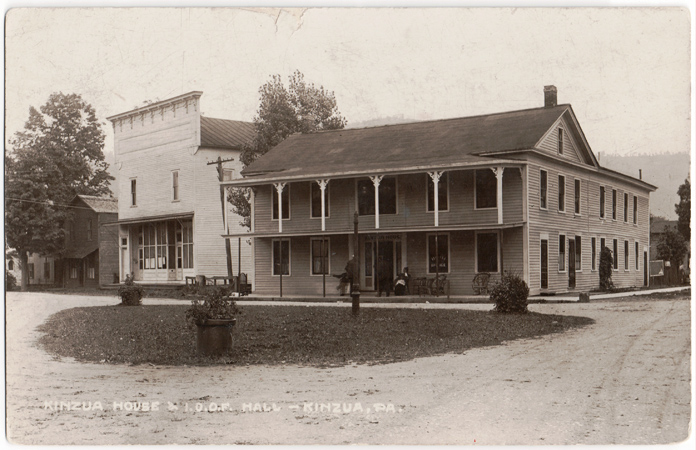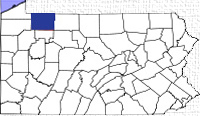KINZUA township lies on the eastern border of Warren county, and is
bounded north by Allegheny River, separating it from the townships of
Glade and Elk, east by Corydon and McKean county, south by Sheffield, and
west by Mead. It is a good farming town, the soil being composed of a sandy
loam along the streams and on Kinzua Flat. The fruits and cereals are raised
here in goodly quantities, while a prosperous dairying interest has sprung up
in the last few years, which adds much to the agricultural growth of the township.
Kinzua was one of the seven towns in Warren county, the organization
of which was effected on the 8th of March, 1821, and was first called "Number
Eight." Its name, it is said, is of Indian origin, the word meaning fish.
This section of the country was in early times one of the favorite resorts of the
Indians during the fishing seasons, who bestowed upon it the peculiar title
which has been adopted by their civilized successors.
Early Settlements.—The original industry here was identical with that of
all the towns in Western Pennsylvania, which could find water channels to the
great lumber markets of early days—viz., lumbering. About the year 1800 a
number of energetic and enterprising men procured the right to strip these
lands of their timber for the purpose of rafting it south to Pittsburgh, Cincinnati,
and the other markets on the great rivers that pour their waters into the
Gulf of Mexico. Among these men (who came then or later) were John Dickson,
who lived on the west side of Kinzua Creek, a little south of the present
residence of William English, our informant. Dickson, though mentioned
first, could not have attained prominence until some years after 1800, as he
lived in town until within five or six years. He was also a great hunter and
fisherman, and cultivated a farm.
The first permanent settler in Kinzua, however, was James Morrison, who
settled on Morrison's Island in 1801. He was soon followed by Benjamin
Marsh, Seaman, Fisher, and others.
Jeremiah Morrison, who is mentioned in the list of taxables of Warren
county for 1806, lived for a time in Kinzua, removed to Cincinnati, and came
again to this town. His was a locomotive disposition. He died a number of
years ago in a canoe, on the way to Tidioute from Kinzua.
Abijah Maddock came here from Cincinnati at a very early day, and began
lumbering on the Indian reservation with John English. Although he was
thus identified, in a manner, with the town, he can hardly be deemed a resident.
He was always going and coming after and with rafts of lumber for the south.
One of his sisters was married to James Morrison. Galen Maddock was a
brother of Abijah, and was connected with this town in the same business.
He died in McKean about thirty years ago.
Between the date of the opening of the country during the first ten years
of the present century, and the setting off and formation of this township in
1821, a considerable immigration had poured into this part of the country,
and affairs looked favorable for the establishment of a prosperous community.
Among those whose names appear in the list of 1822 are the following:
George Blacksnake owned property here in some manner, though he was
an Indian chief of the Seneca tribe, and resided on the reservation at Cold
Spring.
In 1821 John Campbell lived on the west side of Allegheny River, but
soon after removed to Kinzua and settled on the west side of Kinzua Creek, in
the southeast part of the town. He was a farmer, lumberman, etc., and was
fond of hunting. He died some ten or twelve years ago. His widow, it is
said, still lives at the ripe old age of one hundred years, with her son, in Ludlow,
McKean county.
Jacob Hook was one of the most influential men of his day. He resided
on the strip of land which was part of Kinzua until Mead was formed, when it
became a part of that township. Hook was very wealthy, engaging largely in
the lumber business, and erecting a number of extensive saw-mills. He died
in Pittsburgh while there on business.
Jacob Hamlin, a farmer, occupied at this time the site of the present
village of Kinzua, his house standing near the center. He was an uncle of
William English. He removed from here to Chautauqua county, in the State
of New York, and after several other removals settled in Michigan, the place
of his death.
Andrew Marsh, a single man, owned and occupied a good farm in the
northeast part of the town, on Kinzua Flat. He was not, like so many other
farmers of this county at that day, interested in the lumbering trade, but
attended strictly to his agricultural occupation, and was successful. He died
there.
Benjamin Marsh, a half-brother of Andrew, lived very early on Kinzua
Flat, and kept the first store, perhaps, in that part of the country. He afterward
became a resident of Elk township. He was drowned between the
mouth of Kinzua Creek and Warren. He was a farmer and lumberman.
James Morrison, the first settler on what is still known as Morrison's Island
at the mouth of Kinzua Creek, owned the entire island, and on it cultivated
an extensive farm. He died there as early, probably, as 1840. Among his.
sons were Abel, Elijah, and William. Jeremiah, who was mentioned in the:
first paragraphs of this chapter, was a nephew of James. Samuel Morrison,
was an early lumberman, and lived in McKean county, at the head of Kinzua
Flat. At a later time he settled on about the site of the railroad station in
Kinzua, where he died about thirty years ago. Several of his children are
here at the present time.
James Sherley lived for a number of years with Benjamin Marsh, after
which he removed to Glade township. There he reared a large family, and
there he died.
These are only a few of the names of settlers mentioned in 1822, but they
are the most prominent of those who owned property here at that time, and
who remained in town long enough to be remembered by the older inhabitants
of the present day. There were others who afterward achieved prominence,
who at this time resided in town, but had not risen to the position of property
holders.
Of these one of the most prominent was Smith Labree, who was
born at Brintwood, Exeter county, N. H., on the 24th of June, 1797, came to
Kinzua when he was eighteen years of age, and began to work for Jacob
Hook. In one year he returned to New Hampshire, and acted in the service
of his father one year. Again he came to Kinzua, and engaged in lumbering
with John English. Soon after this he purchased of Archibald Tanner a large
tract of land, which embraced nearly the entire site of the present village of
Kinzua. His first house stood on the lot now occupied by that of Emory
Lyle. In addition to his own lumber interests he acted as pilot for others and
made frequent trips down the Allegheny River, once going as far as Natchez,
Miss. The habit in those days was to take down on the raft a large canoe,
and bring it back well filled with provisions. This he did on about every trip.
On the 31st of October, 1822, he married Susannah, daughter of Comfort
Hamlin. Following are the names of his children, together with the dates of
their birth, and of the deaths of those who have died:
Sally, born December 27, 1824, died July 28, 1825; Adaline, born December
22, 1829, died August 4, 1833; Rosina, born March 26, 1832, died July
7, 1863; Rosetta, born June 19, 1834, now the wife of J. O. McManus, of
Kinzua; Loren, born April 20, 1837, died July 27, 1839; Loren, born November
28, 1840, married Mary H. Nett, of Fayetteville, Pa., December 11,
1865,
and now resides in Kinzua; Archibald, born September 17, 1846, died
April 9, 1871. Smith Labree died on the 27th of November, 1860, and was
followed by his widow on the 29th of March, 1867. His son Loren, who now
owns a part of the old estate, has passed his life thus far in his native place,
excepting a period of two years and nine months, which he passed in the
service of the Union cause during the Rebellion. He served under Captain
D. W. C. James, of Warren, in the last company of volunteer infantry raised
in the State, and was also in the last volunteer battery raised in the State,
under Captain William Barrows. His civil occupation has always been that
of a successful farmer. In politics he has been a consistent member of the
Republican party, until the principles of the Prohibition party absorbed his
political faith.
William English, from whom the writer has obtained much of the information
concerning the early settlers of this township, was born in Lycoming
county, Pa., on the 3d day of March, 1818. He was the son of John and
Mary English, who were reared in the county of his birth. John English
brought his family to Kinzua in the year 1821, and two years later settled on
the place still occupied by his son William. John English was an honorable
and successful farmer, and was also engaged to some extent in the lumber
business.
He died in 1868, and in five weeks was followed by his widow. In
1846 William English married Laura E. Parmenter, of Chautauqua county,
N.
Y., who has passed an harmonious period of forty years with her husband.
They have seven children living—viz: Mary Ella, wife of Thomas Fullerton;
Orren, Solon, George W., Charles Fletcher, Alice L., wife of Hector Strong,
and John, who is the only one remaining at the home of his parents. Rice
English, now a resident of Kinzua, is a brother of William.
In 1831 Claudius English, an uncle of William, came to Kinzua and settled
on the site of the village, and passed the remainder of his days within a mile
of his first settlement.
At the time of the formation of the township there were within its limits
but one or two patches of clearing, besides the already large clearing on
Morrison's
Island, which is said by some to have been the work of Indians long
before the arrival of the white man. William Morrison had a small piece
cleared on Kinzua Flat, these two being the only clearings worthy of the name.
There was not a road in town, the only means of travel or transportation being
furnished by the streams and canoes. Wild beasts abounded—bears, deer,
wolves; while rattlesnakes added the terrors of their presence to diminish the
comfort of the human intruders. Wolves were so numerous that it was practically
impossible to keep sheep. There was even danger in the necessary
custom of letting the cows run in the woods, with no other safeguard against
loss than the tintinnabulating cow-bells which depended from their throats.
There was not a sign or suspicion of a village. The inhabitants, few and far
between, were not accommodated with the convenience of a store and delivery
wagons, the nearest place in which to purchase goods and the necessary provisions
of life being at what was then called a store, kept by Benjamin Marsh,
just over the line, in Corydon. Most of the trade of the town, however, was
given to Warren, whither the people made frequent trips in canoes. During
the rafting seasons, also, it was the custom to bring large quantities of provisions
from Pittsburgh by canoe. There was no grist-mill here, the grain
being taken to Warren for grinding. It was not long after this that John
English, Smith Labree, Comfort Hamlin, and John Hamlin built a grist and
saw-mill near the site of the present railroad station, and on the ground now
covered by the mill of H. A. Jamieson. These mills were the first erected
within the present limits of the town, excepting the five mills of Jacob Hook,
which stood on the strip afterward set off to Mead township. As early as
1828 John Campbell, James Stewart, and Robert Arthur, all of whom had
married daughters of Martin Reese, built a saw-mill in the southwestern part
of the town, and operated it until it wore out. Samuel Campbell, son of John,
rebuilt it, and operated it until it went down, some ten or twelve years ago.
The next mill was built several years later by Andrew Merritt and Robert
Campbell about a mile above the mill last mentioned, and near the McKean
county line. Then a number of years later still John L. English and Sylvester
Strong erected another mill a considerable distance below the John Campbell
mill, on Kinzua Creek. About this time Stephen and Jesse Morrison, sons of
Samuel, built a saw-mill on the Allegheny River, near the head of Morrison's
Island; but this and all the other mills have long since gone to decay, and with
the exception of the one first mentioned, which occupied the present site of
H. A. Jamieson's mill, their places know them no more. The grist-mill was
operated first by John English, then by Anthony Courson and others, until a
few years ago Denton & Chattle assumed management and continued their
joint labors for some time. Their successor, the present occupant, W. H.
Hoxie, is worthy of his precession.
The Village.—Until as late as 1850 the town was without the convenience
of a business center of any sort. The first settlers directly on the. site of the
village of Kinzua were Jacob and Comfort Hamlin, Comfort Knapp, and Smith
Labree. Until that time there was no tavern in town, unless the name be applied
to the house of Smith Labree, which, during the rafting seasons, was
thrown open for their entertainment, and afforded all the comforts, but none
of the extraordinary privileges of a licensed tavern.
The principal credit of building up the village belongs undoubtedly to
Sterling Green. He was the eldest of ten children of Seth and Sarah Jane
(Portman) Green, and was born in Pine Grove, Pa., in the year 1816. His
father came from Massachusetts and settled in Pine Grove about 1813, and
married Miss Portman in 1815. The family removed to the head of Kinzua
Flat, in Corydon, where occurred the death of Seth Green in August, 1848.
Sterling went to Warren, and was for a time actively engaged in the lumber
business. In 1848-49 he kept the Mansion House. In 1849, when he came
to Kinzua, he found the site of the village nothing but a farm in the hands of
Smith Labree. This land he purchased, and immediately laid it out into village
lots, kept the first store, and built the first hotel, the Kinzua House, in
1851, and in this way became the author of the village.
The year 1851, the author has been told, is memorable from the laughable
occurrence of a dispute within the town limits in the fall of that year. The
menagerie of G. C. Quick & Co., en route from Warren to Smethport, was
admitted
to the privilege (?) of performing and exhibiting to the people of
Kinzua and vicinity. The proprietor, however, discouraged at the small number
that gathered to see his "greatest show on earth," concluded to move on
without giving the exhibition. The boys of the neighborhood insisted upon
his fulfilling his contract, but nevertheless he began packing his impedimenta
preparatory for departure. He had not proceeded far into the wild road that
led from the town before he discovered "the boys" who had opposed his going
felling trees across his path. They declared that unless the procession
faced about and satisfied the demands of the spectators, they would fill the
road with trees from Kinzua to Smethport. The proprietor, considering discretion
the better part of valor, yielded to their somewhat peremptory importunities,
pitched his tent, performed his agreement, and was permitted to go
on his way unmolested. There are undoubtedly many of those "boys" now
living in Kinzua, who recall the affair with a smile of satisfaction.
Present Business Interests.—Probably no town in the county has received
more unmitigated benefit from the opening of a railroad through its borders
than has Kinzua. It has created a market for all the products of the town,
and has been greatly instrumental in increasing the population of the village.
The oldest mill and also the oldest mill site, as we have seen, in town is
now owned by H. A. Jamieson, of Warren. Mr. Jamieson became the owner of
this property in 1863, and has kept the mill in uninterrupted operation ever
since. The grist-mill of W. H. Hoxie has been mentioned. The present proprietor
has owned the mill, at the present writing, something over a year. The
handle-factory of Mason Sheldon was started about four years ago, as was also
the oar-factory of J. W. Neily.
| Undated postcard bearing the caption: Kinzua House and I. O. O. F. Hall, Kinzua, Pa. |
 |
| Postcard image courtesy of Warren County Historical Society, Warren, Pa. |
The oldest hotel in town is the Kinzua House, which was erected in 1851
by Sterling Green. Mr. Green kept the house himself for twenty years, and
has been followed successively by McIntyre & Langworthy, Eugene Marsh,
William Fogies, Joseph Clendenning, Joseph Hale, and the present landlord,
T. W. Dempsey, who came into the house more than two years ago. The
next hotel was the Maple Shade, which A. T. Banks has kept since June, 1886,
but which was first opened a number of years ago by J. H. Williams. Following
Williams and preceding the present proprietor was L. W. Siggins.
The merchant who has been longest in continuous trade in town is John
H. King, who first opened a store here in 1870. The building which he now
occupies was built by him about four years ago. Mr. King carries stock worth
about $7,000.
Sterling Green has dealt in general merchandise in Kinzua village in all
about ten years, though he has occupied the present building only since the
opening of the railroad and the oil excitement, at which time he caused its
construction.
E. A. Van Scoy and G. W. Morehouse, under the style of E. A. Van Scoy
& Co., erected the store building they now occupy as dealers in hardware in
1880, just previous to the opening of the railroad. They have a good trade,
carrying stock valued at about $6,500.
J. Tate has dealt in general merchandise about five years.
D. G. Blackman built the store which he now occupies for mercantile purposes
in 1882, and after renting it for one year to William Wright, came into
the building himself. His stock is estimated to be worth about $3,000.
In August, 1883, J. W. Green opened a jewelry and drug store here, and
a year later the business was enlarged by the addition of S. Green. The firm
name is now S. Green & Co.
The harness shop of S. Norton & Co. (S. Norton and Norton Cardot) was
established in the fall of 1885. These gentlemen also have shop in Sinclairville,
N. Y.
The first resident physician in town was Dr. Nichols, who practiced here a
number of years following about 1850. Before his settlement in town the inhabitants
were accustomed to call their physicians from Warren, whither they went
on floats. One of the oldest inhabitants has informed the writer that he once
went to Warren for a doctor in the night, when the darkness was so intense that
he could not see the hills on either side of the stream, nor even distinguish the
sides of his float. After Dr. Nichols came Dr. Hector Galloway, a single man,
who, in connection with business as an Esculapian minister, taught school. He
was here four or five years. Dr. Thomas Eddy then came, not far from 1870,
and has been here ever since. Dr. J. J. Knapp, who was born in Farmington,
this county, on the 15th of June, 1854, and was graduated in the spring of
1881 from the College of Physicians and Surgeons at Baltimore, came to
Kinzua
on the last day of March, 1881.
Postmasters.—The first postmaster in town was probably Benjamin Marsh,
who had his office at his house on Kinzua Flat. Jonathan Marsh then held
the office for a time, and was succeeded by Hiram Gillman. Sterling Green
received the first appointment after the removal of the office to the village, or
rather, he removed the office to the village. He was postmaster for eighteen
years. The present incumbent is Mrs. Rose Murray, who owes her position
to the present national administration.
Following is a list of the present officers of the township: Commissioners,
John Smith, L. S. Strong, J. C. Fuller; judge of election, E. A. Weagraff;
inspectors of election, Lovel Gibson, G. K. Brown; school directors, Mason
Sheldon, J. W. Springer, Stephen Harris, R. P. Vanarsdale, H. W. Neily,
G.
W. Moorehouse; treasurer, James Tate; justices of the peace, R. H. English,
D. G. Blackman; constable, A. J. Williams; collector, A. J. Williams; assessor,
Frank L English; town clerk, Frank L. English; auditors, S. O. Campbell,
E. A. Weagraff, J. H. King; pathmasters, district No. 1, Calvin Stoddard;
district No. 2, Marcellus English; district No. 3, George W. English.
Educational.—The first settlers in this township, from 1822 to 1825,
patronized
a school kept within the present limits of Corydon. In 1825 a rude
structure of logs was the first house used for educational purposes in this town,
and was the place where all the schools were kept until 1829. They were supported
by subscription. The teachers in this house were Nelson Seaver, Presene
Corbin, Sophronia Inglesby, and Hiram Gillmore. In 1829 this house was
burned, and for five years schools were kept in several houses, according to
the immediate convenience of the citizens. Rice Hamlin, Edward Evans, and
Amanda Inglesby were teachers during this period. Since 1834 the town has
not been without its regular district schools, which, on the whole, have been
very creditable. The village of Kinzua is now graced with a fine school-house
which was built in the year 1882, and first opened in the fall of that year. The
cost of its construction was something more than $5,000. The first principal
was O. J. Gunning, who has been succeeded by Firth, Daniel Reeves, and the
present principal, Arthur M. Marsh. The school is conveniently divided into
four departments. The average attendance is stated to be about 150 pupils.
Ecclesiastical.—The only church ever within the present limits of Kinzua
township is the Methodist Episcopal Church, which, previous to about 1830,
like all the Methodist churches, was accounted as a part of a circuit. Services
were formerly held in private houses, barns, and wherever convenience, rather
than comfort, dictated. Among the first members of the class formed here
were John, Jacob, and Comfort Hamlin, Samuel, James, Elijah, and Levi Morrison,
John Campbell, and John English, with their wives. About 1848 John
English gave the ground on which at that time the present house of worship
and parsonage were erected, at a total cost of about $2,500. The present
pastor is Rev. Sampson Dimick. The trustees are Loren Labree, Dr. J. J.
Knapp, William English, and others.
|




